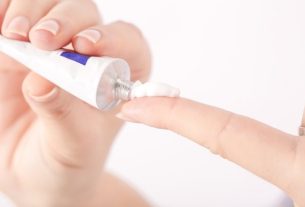Vasomotor rhinitis, also known as non-allergic rhinitis, is a condition that causes inflammation of the membranes inside the nose, producing symptoms such as runny nose, stuffy nose and itching, for example.
Normally, this type of rhinitis can appear at any time of the year and, therefore, is not related to allergies, as is the case with allergic rhinitis, which is more common in specific periods, such as spring or summer, for example. Understand better what allergic rhinitis is.
Although there is no proven cure for vasomotor rhinitis, its symptoms can be alleviated with some treatments recommended by your doctor, such as the use of antihistamines or anti-inflammatories, for example.

Main symptoms
The most common symptoms of vasomotor rhinitis include:
- Stuffy nose;
- Constant runny nose;
- Sensation of phlegm in the throat;
- Itchy nose;
- Redness in the eyes.
These symptoms can last from several days to weeks and are also similar to rhinitis caused by an allergy, so it can be more difficult to identify the correct cause.
How to confirm the diagnosis
The diagnosis of vasomotor rhinitis is usually made by an otorhinolaryngologist, through a complete examination of the nasal passage, which will show swelling of the mucosa caused by the dilation of the blood vessels. Then, the doctor may also order an allergy skin test and blood test to exclude the presence of an allergic reaction.
Make an appointment with the nearest doctor to have your symptoms evaluated, the cause identified and the best treatment started:
Taking care of your health has never been easier!
Possible causes of vasomotor rhinitis
Vasomotor rhinitis occurs when the blood vessels in the nose dilate, which ends up causing swelling and congestion of the tissues inside the nose.
Although the specific reason why the vessels dilate is not yet known, some causes that may be the cause of rhinitis include:
- Exposure to dry air;
- Change in atmospheric pressure and temperature;
- Strong odors;
- Spicy foods;
- Chemical irritants such as ozone, pollution, perfumes and sprays;
- Nose injuries;
- Diseases such as gastroesophageal reflux and asthma;
- Alcoholism;
- Side effects of medications;
- Strong emotions.
Since vasomotor rhinitis is more common in women, it may also be caused by hormonal changes, which are more common in women due to the menstrual cycle.
How the treatment is carried out
There is no cure for vasomotor rhinitis, however treatment can help reduce the intensity of symptoms and improve quality of life. Some of the most commonly used forms of treatment include:
1. Saline solutions
A good way to alleviate rhinitis symptoms is by washing the nasal passages with saline solutions, which can be prepared at home or purchased at pharmacies. Some examples of saline solutions that can be used are Nasoclean or Maresis, for example.
Also learn how to prepare a homemade nasal solution.
2. Nasal decongestants
Nasal decongestants come in tablets, such as pseudoephedrine (Allegra), which exerts a systemic action, or in topical formulations, such as oxymetazoline (Afrin, Aturgyl) and phenylephrine (Decongex), available in drops or sprays. These medications act by causing vasoconstriction and, consequently, a decrease in blood volume and nasal mucosa, reducing the flow of fluids into the nose.
3. Topical corticosteroids
Spray corticosteroids are highly effective in reducing rhinitis symptoms and have the advantage of not causing the same side effects compared to oral corticosteroids.
Some of the medications that can be used to treat allergic rhinitis are beclomethasone (Beclosol Clenil), budesonide (Budecort, Busonid), fluticasone propionate or furoate (Flixonase) or mometasone furoate (Nasonex), for example
Also find out how allergic rhinitis is treated.
When surgery is necessary
Surgery for vasomotor rhinitis is normally only indicated in severe cases, when the symptoms are caused by blockage of one side of the nasal cavity by a deviated septum, hypertrophy of the turbinates or the presence of nasal polyps, for example. In these cases, treatment with medication may not provide relief, making it necessary to resort to surgery to remove the blockage.

Sign up for our newsletter and stay up to date with exclusive news
that can transform your routine!
Warning: Undefined array key "title" in /home/storelat/public_html/wp-content/plugins/link-whisper-premium/templates/frontend/related-posts.php on line 12
Warning: Undefined array key "title_tag" in /home/storelat/public_html/wp-content/plugins/link-whisper-premium/templates/frontend/related-posts.php on line 13




